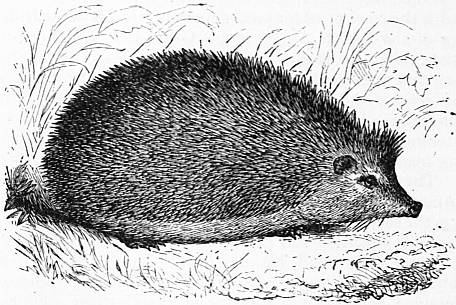Hedgehog
 From Britannica 11th Edition (1911)
From Britannica 11th Edition (1911) Hedgehog, or Urchin, a member of the mammalian order Insectivora, remarkable for its dentition, its armature of spines and its short tail. The upper jaw is longer than the lower, the snout is long and flexible, with the nostrils narrow, and the claws are long but weak. The animal is about 10 in. long, its eyes are small, and the lower surface covered with hairs of the ordinary character. The brain is remarkable for its low development, the cerebral hemispheres being small, and marked with but one groove, and that a shallow one, on each side. The hedgehog has the power of rolling itself up into a ball, from which the spines stand out in every direction. The spines are sharp, hard and elastic, and form so efficient a defence that there are few animals able to effect a successful attack on this creature. The moment it is touched, or even hears the report of a gun, it rolls itself up by the action of the muscles beneath the skin, while this contraction effects the erection of the spines. The most important muscle is the orbicularis panniculi, which extends over the anterior region of the skull, as far down the body as the ventral hairy region, and on to the tail, but three other muscles aid in the contraction.
 |
| The Hedgehog (Erinaceus europaeus). |
Though insectivorous, the hedgehog is reported to have a liking for mice, while frogs and toads, as well as plants and fruits, all seem to be acceptable. It will also eat snakes, and its fondness for eggs has caused it to meet with the enmity of game-preservers; and there is no doubt it occasionally attacks leverets and game-chicks. In a state of nature it does not emerge from its retreat during daylight, unless urged by hunger or by the necessities of its young. During winter it passes into a state of hibernation, when its temperature falls considerably; having provided itself with a nest of dry leaves, it is well protected from the influences of the rain, and rolling itself up, remains undisturbed till warmer weather returns. In July or August the female brings forth four to eight young, or, according to others, two to four at a somewhat earlier period; at birth the spines, which in the adult are black in the middle, are white and soft, but soon harden, though they do not attain their full size until the succeeding spring.
The hedgehog, which is known scientifically as Erinaceus europaeus, and is the type of the family Erinaceidae, is found in woods and gardens, and extends over nearly the whole of Europe; and has been found at 6000 to 8000 ft. above the level of the sea. The adult is provided with thirty-six teeth; in the upper jaw are 6 incisors, 2 canines and 12 cheek-teeth, and in the lower jaw 4 incisors, 2 canines and 10 cheek-teeth. The genus is represented by about a score of species, ranging over Europe, Asia, except the Malay countries, and Africa.
↧ Download as ZWI file | Last modified: 11/17/2022 15:23:51 | 28 views
☰ Source: https://oldpedia.org/article/britannica11/Hedgehog | License: Public domain in the USA. Project Gutenberg License
 ZWI signed:
ZWI signed: KSF
KSF